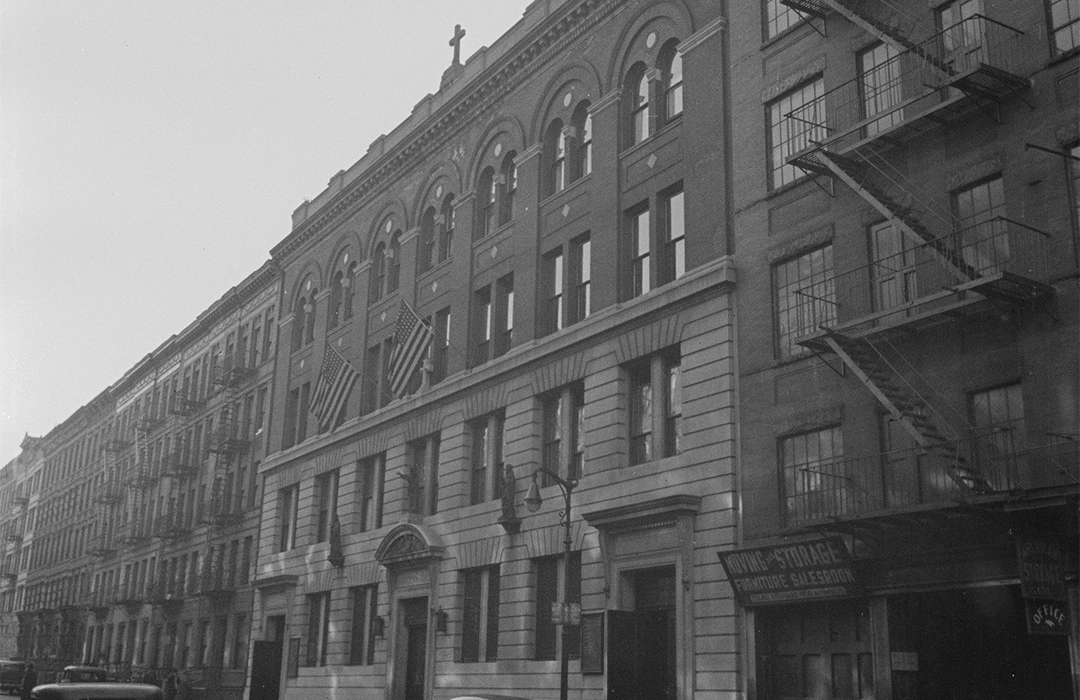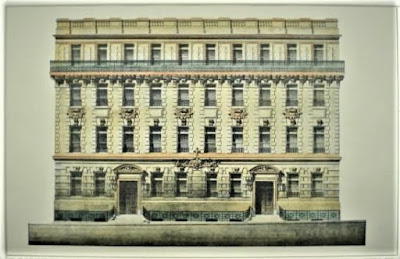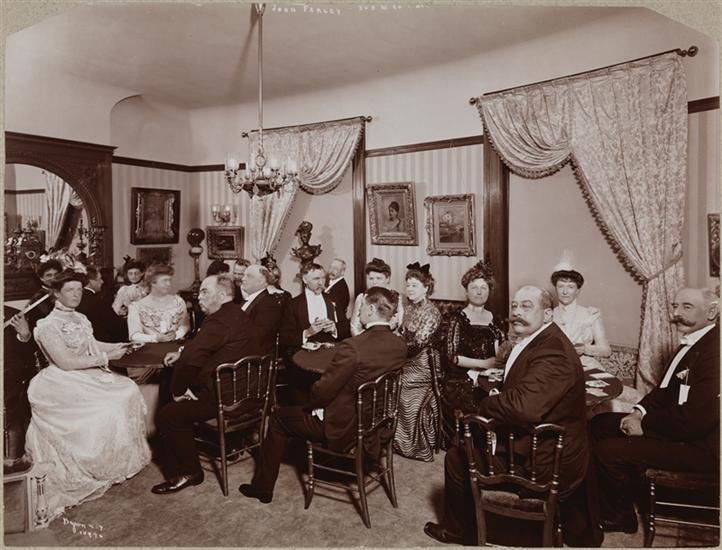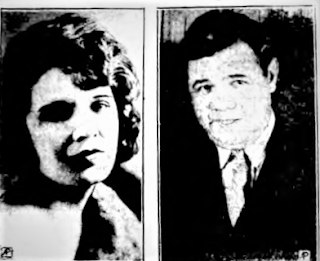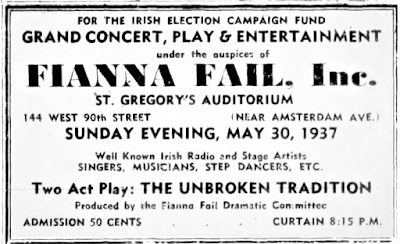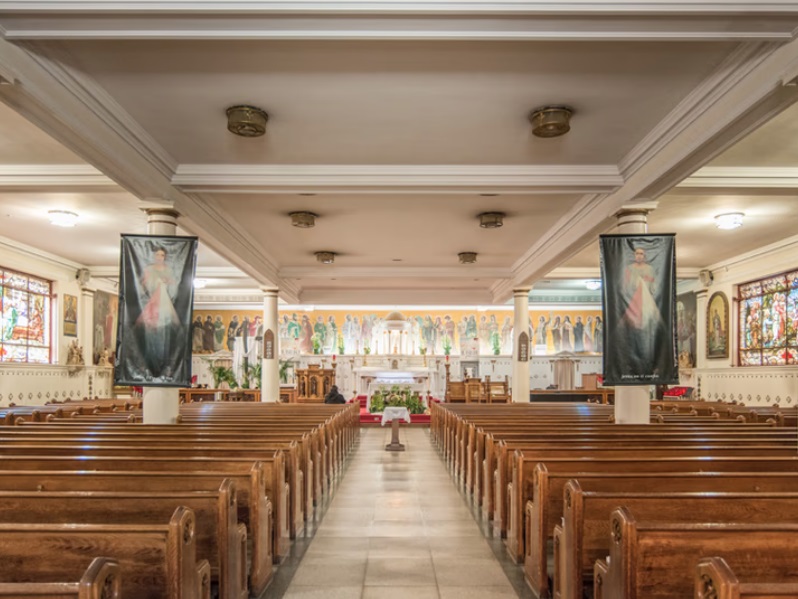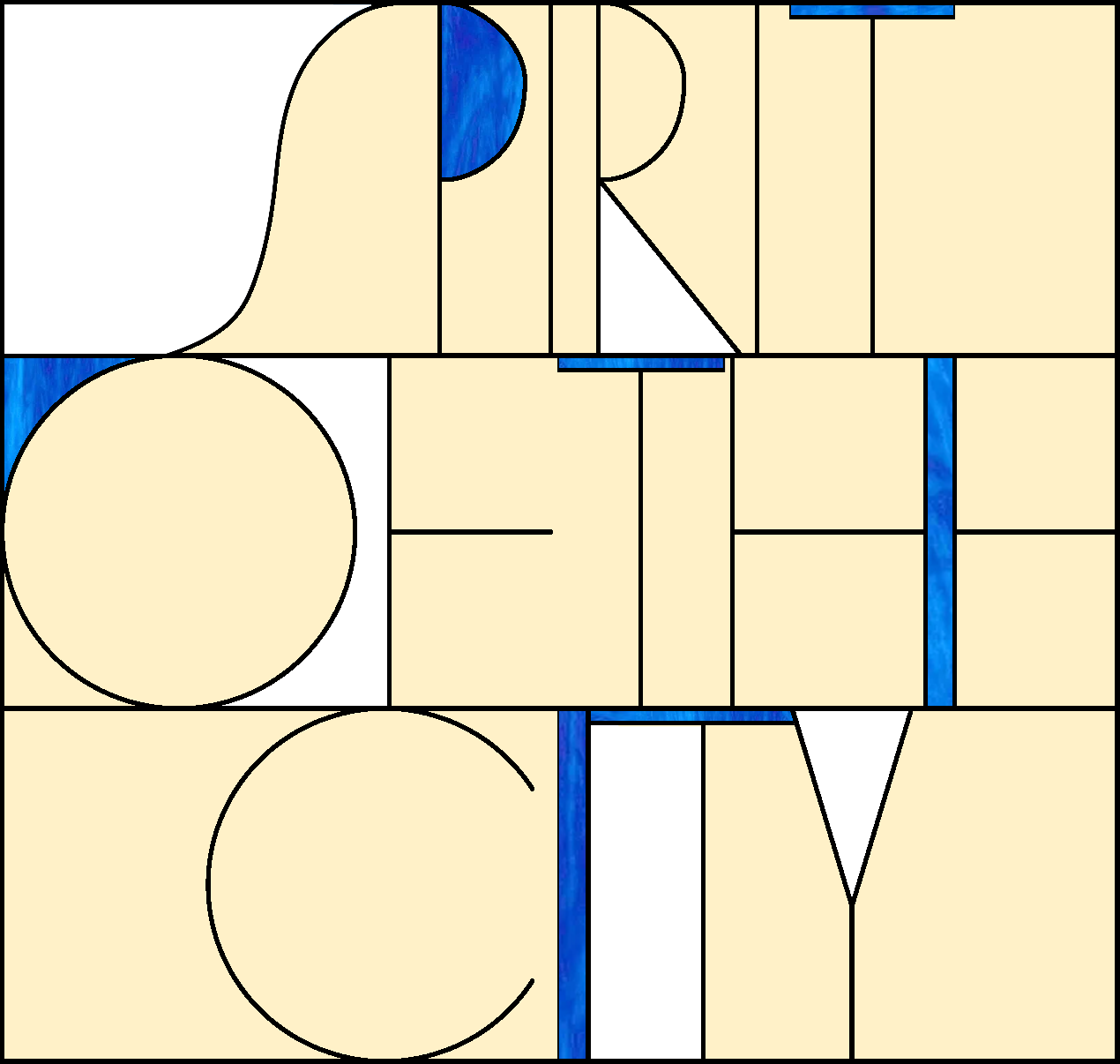
St. Gregory the Great
138-144 West 90th Street
by Tom Miller
In 1908, the expansive Philip Wagner & Sons livery stable had operated at Nos. 138-144 West 90th Street, between Columbus and Amsterdam Avenues, for years. Collier’s magazine, on October 1st of that year, called Wagner “the well-known undertaker and livery stable man.”
However, before the end of the year, horses and vehicles were replaced in the stable by worshipers. To serve the burgeoning Roman Catholic population in the developing neighborhood, Cardinal John Murphy Farley created the parish of St. Gregory the Great in 1906. In 1908, Fr. James Fitzsimmons was appointed its pastor. After worshiping in another stable on West 89th Street, the parish moved into the Philip Wagner & Son stables in time for Christmas services.
On May 10, 1912, architect Elliott Lynch filed plans for a four-story brick school on the site. The cost of construction was projected at about $2.67 million in today’s money. The popular history is that the parish intended to use the basement and ground floor chapel only until a proper church building could be erected. It would seem that, if that were so, those plans changed rather early on.
Lynch was responsible for several church and school buildings. One in particular, St. Stephen’s Parish School, designed in 1904, anticipated the St. Gregory the Great school. As the building took shape, cornerstone-laying ceremonies took place on October 27, 1912. The Sun reported, “Half an hour before the cornerstone laying took place a procession formed at the rectory at 156 West Eighty-eighth street.” The procession was led by three cassock-wearing acolytes, two carrying candles alongside the boy carrying the cross.
“Behind them marched the band of St. Vincent’s Home in Brooklyn,” said the article. “Then followed the autos and carriages containing the monsignors and priests, flanked by the uniformed fourth-degree Knights of Columbus, who acted as escorts to Mgr. Mooney.” A temporary platform had been erected for the occasion. The contractor, Thomas J. Waters, provided the sterling silver trowel used by the monsignor in the ceremony.
The report hinted that the parish had altered its intentions to erect a separate church building by now. The construction costs had increased by fifty percent and the article noted “The basement and ground floor of the new building will be used as a church and the three upper floors for school purposes.”
One year later, on October 19, 1913, Cardinal Farley dedicated the structure. Lynch’s four-story structure sat on a rusticated stone base. The paired openings were capped by splayed lintels. The east and west doorways, one for the rectory and the other for the school sat below prominent bracketed cornices. The central doorway, to the church, was distinguished by a Renaissance arched pediment. The upper two stories made an about-face style-wise. Stone gave way to red brick and Renaissance turned to Romanesque. The arches-within-arches motif smacked of the Rundbogenstil style, or German neo-Romanesque, popular decades earlier. A bracketed stone cornice finished the design.
At the time, the church’s congregation was heavily Irish. In 1919, the Irish American Advocate announced, “On Monday and Tuesday evenings, November 22 and 23, the Edward Daly Branch, F. O. I. F. [Friends of Irish Freedom], gave an entertainment and dance in St. Gregory’s School Hall, 144 West 90th Street, for the benefit of the victims of British brutality in Ireland.”
The Church of St. Gregory the Great would, of course, be the scene of scores of weddings and funerals. One early funeral here, however, stood out. Known popularly as the “Caudillo de la Revolución,” or “Leader of the Revolution,” Francisco I. Madero became President of Mexico in October 1911. However, before long the leader was opposed by even more radical revolutionaries. He was arrested and then assassinated on February 22, 1913. Members of his family, including his father, escaped to New York. Francisco Madero, Sr. lived in an apartment at 302 Central Park West. He died there of a heart attack on September 3, 1916.
Two days later The Sun reported, “Prominent Mexicans, who were active in affairs across the border prior to the murder of Francisco I. Madero were seen yesterday morning at the funeral of Francisco Madero, father of the ex-President, which was held in the Roman Catholic Church of St. Gregory.” Former Mexican military leaders and government officials were present for the ceremony. The newspaper wrote, “Heaped high on the massive bronze casket were many flowers sent from all parts of Mexico and the United States.”
As with all parishes, young members left to fight in World War I, and Catholic priests sailed off to serve as Army chaplains on the front. Twenty-eight of St. Gregory the Great’s parishioners never returned from Europe. As one by one the priests were discharged from military service, they were reassigned to parishes. On February 17, 1919, The Sun reported that one of them, Rev. Thomas H. Dean had been appointed by Monsignor Mooney as assistant to Rev. Dr. William F. Hughes at St. Gregory the Great.
At the time, the church’s congregation was heavily Irish. In 1919, the Irish American Advocate announced, “On Monday and Tuesday evenings, November 22 and 23, the Edward Daly Branch, F. O. I. F. [Friends of Irish Freedom], gave an entertainment and dance in St. Gregory’s School Hall, 144 West 90th Street, for the benefit of the victims of British brutality in Ireland.”
The staging of the events here was not coincidental nor was the hall merely rented to the group. Rev. Thomas F. X. Walsh of St. Gregory the Great was “the main feature of the evenings,” providing an illustrated lecture. Walsh had recently traveled throughout Ireland and his talk “related almost entire to the struggle of the Irish against British tyranny.”
If the parish truly intended to erect a separate church structure, they had now refocused their financial priorities. On June 4, 1920, The Kingston Daily Freeman reported that “Rev. Dr. Hughes of St. Gregory the Great, at 144 West 90th Street, New York City, has purchased for a recreation farm 100 acres” near New Paltz, New York. The article noted, “for some time Dr. Hughes and Father Walsh have been in search of a farm of this character.” Recreation farms afforded city children and their parents periods of fresh air and sunshine and the opportunity to work with farm animals. “Dr. Hughes anticipates erecting a chapel upon the farm, which he has named ‘Our Lady of the Wayside,’ after an ancient shrine in Rome, where he spent his vacations when a student at college.”
The parish and its leaders continued to be proactive in political and social causes. In 1925 the parishioners held a “public forum in the school hall” regarding the proposed termination of the emergency rent laws, passed in 1920 to protect tenants from arbitrary rent increases. The school hall was, incidentally, the location of the meetings of the Irish Speakers’ Society at the time.
Decidedly not of Irish extraction was star baseball player Babe Ruth. And yet early on the morning of April 18, 1929, while a handful of early worshipers said silent prayers having arrived early for the 6:30 mass, he and former actress Mrs. Claire Hodgson strode up the aisle to the altar around 5:45 and were married. The news reached fans throughout the country. The Ballston Spa Daily Journal in upstate New York wrote “In strange contrast to the boisterous diamond personality of the New York Yankee slugger, the wedding took place in the quiet dignity of the parish neighborhood church, conducted by Father William H Hughes.” The Lockport Union-Sun and Journal added, “Two altar boys who served the mass were promised autographed baseballs by Ruth.”
Similar events continued throughout the years. On March 7, 1936, The Advocate reported, “A class of 200 men from the various New York County divisions of the Ancient Order of Hibernians received the major degrees of the order Sunday, Feb. 23, in the school hall of the Church of St. Gregory, 144 West 90th street. The following year a concert, play, and variety show was held in the hall for the benefit of the Irish Election Campaign Fund. The plot of the play, The Unbroken Tradition, took place during the 1916 Irish rebellion. The Advocate said, “It is 100 percent Irish in its every line and portrays the indomitable courage which kept the spirit of liberty alive for hundreds of years.”
The hall was crowded on May 19, 1942, when Father George Maguire, in America from Ireland, sang. The Advocate called him “one of Ireland’s chief exponents of ancient and modern Celtic musical culture” and described his appearance here as a “descriptive song recital.”
The 1960s were a time of political and social upheaval in the United States. Streets filled with protesters against the Vietnam War, and “counter-culture” demonstrators rallied against poverty and social injustice. Visible among them was St. Gregory the Great’s pastor Rev. Henry J. Browne. Browne vocally accused the city of not providing enough low-income housing. “We need to listen to the poor themselves,” he urged.
More activist in his social stance than Brown was Rev. Philip F. Berrigan of Maryland. At an anti-war protest in Baltimore on October 27, 1967, he poured blood on draft records, and at a subsequent rally on May 17, 1968, in the same city, he burned Selective Service cards. The priest was found guilty on charges of destroying and mutilating Selective Service records and was ordered to surrender on April 9, 1970, to begin a six-year prison term. He did not show up.
Instead, he had come to New York City to attend a peace rally. He was staying with Father Browne and was tracked to the rectory of St. Gregory’s on April 21. F.B.I. agents rang the bell but got no answer. And so, as reported in The New York Times, they “broke through the door to the church study when they failed to get an answer to their rings the door was locked.”
Rev. Berrigan and a poet, David M. Eberhardt, were arrested. The Times added “The Rev. Henry Browne, pastor of St. Gregory’s, welcomed the Federal agents to the church and told them the hours of Sunday masses, ‘should you wish to return.'”
The following year, on March 21, 1971, the hall was the scene of another well-publicized rally. A group of Roman Catholic priests, a nun, and a Pakistani scholar had been dubbed “the Harrisburg Six” by newspapers after being charged for plotting to kidnap Henry A. Kissinger and to bomb the heating plants of several Washington D.C. Federal buildings.
The New York Times reported, “The nun, Sister Elizabeth McAlister, and the scholar, Dr. Eqbal Ahmen, and two of their alleged co-conspirators, Sister Jogues Egan and Thomas Davidson, addressed more than 200 persons at a rally in the rectory of St. Gregory the Great, a Roman Catholic church, at 144 West 90th Street.” The newspaper reported that Sister McAlister urged the supporters not to be “distracted” by the indictment and instead focus on the main issues, “ending the war in Indochina and what they call repression in the United States.”
A group of Roman Catholic priests, a nun, and a Pakistani scholar had been dubbed “the Harrisburg Six” by newspapers after being charged for plotting to kidnap Henry A. Kissinger and to bomb the heating plants of several Washington D.C. Federal buildings.
On December 14, 2014, The New York Times reported, “The sweeping reorganization of the Roman Catholic Archdiocese of New York…is likely to involve the merger or the closing of significantly more parishes than was originally announced.” The Church of St. Gregory the Great escaped the threat until February 2017 when the Archdiocese of New York announced it had decided to close the school and to end regular masses. The announcement promised that current students would be provided space at another parochial school.
The announcement signaled the end of a most vibrant chapter in Upper West Side social history. Today the building is home to the Geneva School, a private Christian faith elementary school founded in 1996.
Tom Miller is a social historian and blogger at daytoninmanhattan.blogspot.com

